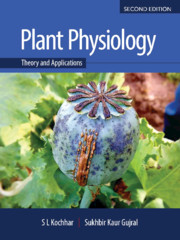Book contents
- Frontmatter
- Contents
- Foreword
- Preface to the Second Edition
- Preface to the First Edition
- Acknowledgements
- Some Common Abbreviations used in the Text
- Abbreviations for Units
- Unit I Water and Mineral Translocation in Plants
- Unit II Metabolism and Bioenergetics
- Unit III Growth and Development
- Unit IV Physiological Stress and Secondary Metabolites – Their Role in Metabolism
- Unit V Crop Physiology – An Innovative Approach
- Unit VI Breakthroughs in Plant Physiology
- Unit VII Some Experimental Exercises
- Glossary
- References
- Index
- Colour Plates
Chapter 6 - Enzymes
Published online by Cambridge University Press: 12 May 2020
- Frontmatter
- Contents
- Foreword
- Preface to the Second Edition
- Preface to the First Edition
- Acknowledgements
- Some Common Abbreviations used in the Text
- Abbreviations for Units
- Unit I Water and Mineral Translocation in Plants
- Unit II Metabolism and Bioenergetics
- Unit III Growth and Development
- Unit IV Physiological Stress and Secondary Metabolites – Their Role in Metabolism
- Unit V Crop Physiology – An Innovative Approach
- Unit VI Breakthroughs in Plant Physiology
- Unit VII Some Experimental Exercises
- Glossary
- References
- Index
- Colour Plates
Summary
Historical Background
The use of enzymes by mankind dates back to the Greek civilization, that first used enzymes in the process of fermentation to produce wine. After the discovery of the catalytic process in the early nineteenth century, a Swedish chemist, Brazelius (1836) suggested that the numerous chemical reactions in living organisms might depend upon the presence of catalysts within the tissues. In 1857, Louis Pasteur, a French scientist demonstrated the involvement of ‘living, intact’ yeast cells in the process of alcoholic fermentation and proposed the term ‘ferments’ for these biocatalysts. The term ‘enzyme’ was later coined by Kuhne (1878) for soluble ferment of yeast or bacteria. However, a significant breakthrough in the study of enzymes was made when the Buchner brothers (1897) in Germany accidentally discovered that the ‘squeezed out’ juice from non-living yeast extract when mixed with sugar could bring about fermentation. Yeast juice is now known to be a mixture of at least twelve different catalysts. The name ‘enzyme’ was coined for the postulated catalyst in juice.
The chemical nature of enzyme remained uncertain until Sumner (1926) purified and crystallized first, the enzyme ‘urease’ from Jackbean (Canavalia ensiformis) and further discovered that it was proteinaceous in nature. Thereafter, hundreds of enzymes have been separated in a pure or semi-pure state and all have proved to be proteins except for ribozymes.
Characteristics of Enzyme-catalyzed Reactions
• High rates of reaction: Enzyme-catalyzed reactions have typically 106–1012 times higher rates as compared to uncatalyzed reactions. Most of enzymes have the capability to convert thousands of substrate into product molecules every second.
• High specificity: Enzymes have the capablility to recognize extremely minute and specific differences in substrate as well as product molecules and can even distinguish between mirror images of any molecule (stereoisomers or enantiomers) e.g., D-Galactose and L-Galactose.
• Mild reaction conditions: Enzymatic reactions usually take place at atmospheric pressure, relatively low temperatures and within a narrow range of pH (approximately 7.0) except for certain protein-degrading enzymes in vacuoles which function at pHs near 4.0, or enzymes present in thermophilic bacteria that can survive in hot sulphur springs (at 100 °C).
- Type
- Chapter
- Information
- Plant PhysiologyTheory and Applications, pp. 168 - 200Publisher: Cambridge University PressPrint publication year: 2020



